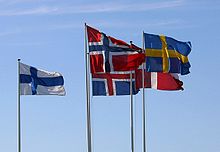Nordic countries
Nordic countries or the North (Danish / Norwegian / Swedish Norden, Icelandic Norðurlöndin, Faroese Norðurlond, North Sami Davviriikkat) refers to the northern European states of Denmark, Finland, Iceland, Norway and Sweden, including the autonomous territories of the Faroe Islands, Greenland (both part of Denmark) and Åland (part of Finland). The Nordic countries cover just under 3.5 million km² and have a population of just over 26 million.
The term is not necessarily congruent with Northern Europe, which, depending on the definition, sometimes includes the entire Baltic States, the north of the European part of Russia or the United Kingdom, or its northern part, Scotland. However, these countries are usually more closely related linguistically, culturally, politically and historically to other countries, which is why a conceptual demarcation of the Nordic countries from Northern Europe arises.
The majority populations of Denmark, the Faroe Islands, Iceland, Norway, Sweden and Åland speak North Germanic languages, whereas Finnish, the Sami languages and other minority languages in the north belong to the Uralic language family. The Inuit in Greenland speak Kalaallisut, an Eskimo-Aleutic language. The Danish-speaking southern Silesians, the inhabitants of the British islands of Shetland and Orkney, whose North Germanic language Norn died out in the 18th century, and the Estonian Swedes also have linguistic and cultural links with the North.
The Scandinavian countries (Denmark, Norway, Sweden) formed a common North Germanic cultural area since the Iron Age and were united into three larger kingdoms at the end of the Viking Age. Finland came under Swedish influence in the Middle Ages. The five modern countries have also been closely linked politically and economically since at least the time of the Kalmar Union (15th century); since 1952 their cooperation has been formalized in the Nordic Council. Today, the Nordic countries share the Nordic model of society to a greater or lesser extent and are all among the most technologically advanced countries in the world.
The five Nordic countries Denmark, Finland, Iceland, Norway and Sweden have their embassy chanceries in Germany in a common complex, the Nordic Embassies in Berlin. It consists of five individual buildings with a common, public building, connected by a surrounding copper band. The building is symbolic of the close cooperation between the Nordic states.

The Nordic countries

Flags of the Nordic countries
Overview and international organizations
Despite their geographical proximity and often common history, the Nordic countries display great political and linguistic diversity. They are also represented very differently at the international level, contrary to the "Scandinavianism" and objectives of, for example, the Nordic Council.
| Nordic countries | ||||||||
| Sweden | Denmark Denmark | Finland | Norway | Iceland | Gronland | Faroe | Åland | |
| Inhabitants (in millions) | 10,33 | 5,82 | 5,53 | 5,37 | 0,364 | 0,056 | 0,052 | 0,030 |
| State | Monarchy (1523) | Monarchy (10th century) | Republic (1917) | Monarchy (1905) | Republic (1944) | Auton. Nation (1979) | Auton. Nation (1948) | Auton. Prov. (1921) |
| Acting Head of Government | Stefan Löfven | Mette Frederiksen | Sanna Marin | Erna Solberg | Sigurður Ingi Jóhannsson (ad interim) | Múte B. Egede | Aksel V. Johannesen | Katrin Sjögren |
| Official language(s), | Swedish (Eastern Scandinavian), | Danish (Eastern Scandinavian), | Finnish and SwedishM | Norwegian (West Scandinavian) and Sami M: Kven. | Icelandic (Western Scandinavian) | Greenlandic (Inuit) and Danish | Faroese (West Scandinavian), Danish | Swedish |
|
| Member since 1952 | Member since 1952 | Member since 1955 | Member since 1952 | Member since 1952 | Council of Ministers since 1971 | Council of Ministers since 1971 | Council of Ministers since 1971 |
| Western Norse Council | since 1985 | since 1985 | since 1985 | |||||
|
| since 1949 | since 1949 | since 1949 | about Denmark | about Denmark | |||
| EFTA/EEA | Member 1960-1995 | Member 1960-1973 | Assoc. 1961, Member 1986-1995 | since 1960 | since 1970 | |||
| European Union | since 1995 | since 1973 | since 1995 | Ref. 1972 & 1994 against accession | was a candidate for EU membership as of summer 2010, application for membership withdrawn on 12 March 2015 | via Denmark from 1973, withdrawal 1985 | 1972 against accession | since 1995 according to Ref. |
| Currency | SEK, Euro ref. 2003 | DKK, ERM II | Euro since 1999 | NOK | ISK | DKK | DKK | Euro |
| North. Passport Union | since 1954 | since 1954 | since 1954 | since 1954 | since 1954 | |||
| Schengen | 1996/2001 | 1996/2001 | 1996/2001 | 1996/2001 | 1996/2001 | |||
See also
- Swedish model
Search within the encyclopedia